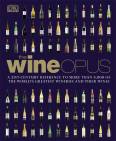The Wine Opus, various authors
| Title of book: | The Wine Opus |
| Author: | Various. Editor-in-chief Jim Gordon |
| Publisher: | Dorling Kindersley |
| Publication date: | 2010 |
| ISBN | 978 1 4053 5267 3 |
| Pages: | 800 |
| Price: | £50 |
 The weight of this ambitious tome may break the back of a less substantial coffee table, but don’t let that be a deterrent. Do consider mail order though.
The weight of this ambitious tome may break the back of a less substantial coffee table, but don’t let that be a deterrent. Do consider mail order though.
The brief for the team of 38 writers, with specialist country or regional interests, was to recommend the best wineries in their specialist area, as well as emerging producers who may become future classics. Some 4,000 wineries from across the wine-producing world are listed, with a tight profile on each winery and its style.
There are also introductions to each region, with maps and plenty of label, and full bottle, shots which remind the reader what the book is all about. I prefer the full bottle shots, though they take more space. I can envisage grasping the bottle and feeling its shape and heft, and pouring it, which can’t be done so easily with just the label shot.
Rising stars are helpfully asterisked, and frequent sidebars provide snippets of information on interesting and extraneous matters. They are usefully headed, for example wine architecture (the new Cos d’Estournel cellar), wine people (Denis Dubourdieu, John Gladstones, Alvaro Espinoza), wine and food (Burgundy’s Bresse chickens and Epoisses, Rhône truffles, canard in France’s south west), wine travel (Vergisson and Solutré of Maconnais, Alsace, Liguria), wine styles (Provence Rosé, carignan renaissance, several pinot noir stories), etc. Sidebars on the other page highlight the main grapes and recent vintages for each region.
Websites are detailed and we’re told if a producer has no visitor facilities.
My main point of irritation is the horizontal line separating producer entries in fact doesn’t separate them. The line divides the text from the address/website of the producer above the line. A small point, and it’s not too onerous to acclimatise.
Another small irritation is that producers are arranged alphabetically by the first name rather than the surname. So you must know that Selvapiana is a Fattoria, that Angerer’s first name is Kurt, that Pingus is a Dominio, etc., but as this book seems more for thoughtful browsing rather than specific reference, this is no big deal. Just something to be aware of.
Otherwise the book succeeds admirably. It’s easy on the eye, there are some picturesque double page picture spreads, and the texts are written in friendly and informative styles.



